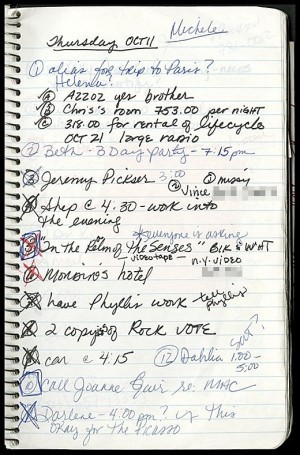With Ron Paul, Fighting for Minnesota
by Abe Sauer

They are young — so young. Impossibly young for attendees of a political rally that does not happen on a street. The slowest moving of the thousand or so streaming into the Minneapolis Convention end up standing for Ron Paul’s address on the eve of the Minnesota caucuses. But they’re young enough to handle it.
A Ron Paul rally is an experience every cynical, bedraggled, politics-reporting cur should take in at least once in a career. Plus, in the GOP 2012 field, Ron Paul supporters easily hold the title of most bangable.
The event was set to begin at 7:00 p.m. The first “End the Fed!” chant started at 7:03 p.m.
When Gingrich, Santorum and Romney voters are all dead of old age, and when the current Tea Party’s core has moved to a senility where the only bailout that concerns them is the one in their pants, Ron Paul supporters will still be, like, 43. The Tea Party desperately needs to recruit younger, fresher members. This realization was certainly why the first pre-Paul speaker is Walter Hudson, chair of Minnesota’s North Star Tea Party Patriots.
The current mainstream of self-identifying Tea Partiers loathes Ron Paul because he’s the guy who shows up with Jack Daniels to a party of 12-year-olds who are pretending to be drunk on O’Doul’s. Paul’s very presence makes a mockery of every Sarah Palin Tea Party “liberty” t-shirt, every Eric Cantor “freedom” bumper sticker and every bedazzled bald eagle. Paul’s events expose the mainstream Tea Party for the fundamentally Christian conservative organization it really is — the kind of “party of the Constitution” that nonetheless wants to legislate bedrooms and can pretzel its reasoning into supporting the likes of Gingrich and Santorum, who are exactly those career political tumors of the D.C. system that the movement claims to despise.
Not that the religious right was absent at Paul’s event. One man discreetly passed out business cards advertising “Live Christian Talk Radio” from the Liberty Broadcasting Network: “Can you handle the truth?”
But Paul didn’t evoke the Lord at any time during the address. He didn’t once mention “faith.” Paul’s rally speeches are unique not in what they mention, but in what they skip.
A Ron Paul for President rally is unlike rallies for other GOP presidential hopefuls in that, surprisingly, it is about the candidate himself. Bachmann. Gingrich. Those attending their rallies are often anti-Obama, not pro-candidate. Mitt Romney’s very existence is a testament to this. There is almost no such thing as a truly pro-Romney conservative. Romney’s the Rumsfeld candidate: you go to the election with the candidate you have, not the candidate you might want or wish to have at a later time.
Paul’s full address only mentioned Obama’s name once. Once! And that was a passing slam of “Obamacare” as a big government program. One breath later and Paul was back to landing blows on “both parties” and how “we need to clean house.”
“It all comes down to the next 24 hours!” said Ron Paul’s Minnesota chair, just before Paul came on. The campaign knows Minnesota’s February 7th caucus could be its biggest day ever. Paul is out-fundraising the other candidates in Minnesota, and the Texas congressman must be giddy that polling during Nevada’s Saturday primary demonstrated that those looking for the “conservative alternative” to Romney had passed over Santorum and Gingrich for Paul. What’s more, Minnesota’s wear-your-neighbors-down caucus system is the perfect composter for the vocal vim and vigor of Paul’s supporters.
This is certainly why Paul’s state chair passed up idealist talk of liberty or the Constitution in favor for a simple point a first-grader could understand. She even rammed it home by talking about “my favorite Youtube,” which, it turns out, is Pacino’s “inch by inch” speech from Any Given Sunday. (A damn good speech.) The crowd was charged.
Her only message was to make all present promise to, immediately after leaving, call one other person and convince that person to caucus tomorrow. Just one. Call one person, make him or her go with you. Got that, stupid? One person. One person to the caucus. All cheered. I bet every one of the thousand or so were determined to make that call.

I would have expected to see more doctor puns at a Ron Paul event.
There are 19 medical doctors in Congress (three senators); that’s an increase from 15 in 2009. (Trivia: Five doctors were among the 56 people who signed the Declaration of Independence.)
Five of the 19 are Obstetrician-Gynecologists, and two of them are from Texas. They are Tom Coburn (R-OK), Phil Gingrey (R-GA) Michael Burgess (R-TX), Phil Roe (R-TN), and, of course, Dr. Paul (R-Atlas Shrugged). For some reason, Republican obstetricians abound. (My daughter was delivered by Grand Forks, North Dakota mayor and Ob-Gyn, Mike Brown — a Republican.) In fact, all but one of the 19 doctors in Congress are Republicans. The lone Democrat is Jim McDermott (D-WA) — and of all of the Congressional medical professionals, McDermott is the only psychiatrist.
One Ob-Gyn offered me a theory on this breakdown, in two parts. First, doctors are really just small businesspeople in a heavily regulated industry. As such, they are especially vulnerable to government meddling and the kind of mandates born of drop-ceilinged conference rooms, campaign donations and ideology, not blood-on-the-Danskos experience. This small-business ideology also ties into a hate for taxes. While most doctors make a good living and some make a wildly good living, often doctors make that income sweet-spot that’s high enough to attract the worst rates, but not so high as to allow for fuck-you money. Guess who often makes just over that $250,000-a-year mark Democrats like to use in talk of raising taxes on the wealthy? Your doctor.
Second, the Ob-Gyn suspects that the specialty — unlike, say, orthopedic surgery — is most exposed to the vile parts of the nation’s entrenched social welfare system, where many Randians see the proverbial bootstraps sold for cash to buy drugs. It’s hard, the doctor argues, to not get just a little bit Ayn-Randy when facing a spirit-crushing daily grind of the tragedy that happens when pregnancy meets deep poverty. The doctor added that these are the Ob-Gyns that see abortion used repeatedly as a birth control measure — and then become activists about it.
Paul is very anti-abortion. But as an Ob-Gyn he’s also characteristically “in limbo” about it. Grilled about performing abortions even in the case of rape, Paul’s answer to Piers Morgan was one many Ob-Gyns who work without the luxury of it being a theoretical argument would agree with: “It is absolutely in limbo. Because an hour after intercourse or a day afterwards… there is no legal or medical problem. If you talk about somebody coming in and they say, I was raped and I’m seven months pregnant and I don’t want to have anything to do with it…. It’s a little bit different story.”
But Paul’s pro-life bona fides were not on display at the rally. Unlike the t-shirts and bumpers at many other conservative candidate events, there were no “If You’re Pregnant, It’s a Baby,” “Abortion: Be Glad Your Parents Chose Differently,” “Choose life. Your Mother Did,” or “Kill the Rapist, Not the Baby.”
Then there is tort reform. Outside abortion, nothing makes a physician want to go into politics more than having been needlessly sued two, three or ten times.

Here are the things, in order from least to most, that got the loudest boos during a Ron Paul rally:
4) Rick Perry
3) The National Defense Authorization Act
2) The “War on Drugs”
1) The Patriot Act

In a way, the worst enemy of a Ron Paul rally is Ron Paul. Paul had been speaking for somewhere around a half hour and the crowd was whipped into a Liberty lather, all ready to rush out into the unbelievably warm Minneapolis winter night and do exactly what Paul needs more than anything: GOTV (Get Out The Vote).
Instead, Grampa Ron continued talking for another 25 minutes or so. It’s like a TED talk about the Constitution, after which a person just kind of wants to go watch some goddamn “Jersey Shore,” because, Jesus, can you stop lecturing for, like, ten minutes? That Paul isn’t the GOP field’s multiple-divorcée is maybe the most surprising story of the 2012 primary. Maybe Mrs. Paul is deaf. [Editor’s Note: Carol Wells Paul, Ron Paul’s wife since 1957, is not deaf.]
So all of the momentum the event had going for the first half hour was then sponged up by Paul droning on about 9/11, the conspiracy of the Iraq War, SOPA and every other recent affront to Constitutional freedom and personal liberty.
Maybe Ron Paul just isn’t used to being in a position to actually win a state. Maybe the Congressman’s message has sat under the heat-lamp for so long even he doesn’t really believe it’s going anywhere in his lifetime.
Still, at the end, the crowd went bonkers again. Paul waved a bit but scurried offstage immediately. For an indie rock act determined to maintain an aura of anti-fame cool, this might be a good approach. But this is politics, where painfully begging adoration and support is pretty much the name of the game.
On his way off stage, Paul was glitter-bombed by a man desperate to prove that even the politically progressive can be miserably uninformed assholes.

Leaving the convention center was a little like leaving a mall movie theatre after the stores were all closed.
Young men and women signed clipboards, took photos together and grabbed complimentary copies of the Ron Paul Family Cookbook. It’s a merry group that, despite Paul’s final desperate attempts to rob them of their crazed energy, just might caucus the Congressman into the national conversation today. From down the hall, one of a foursome yelled, “Come on, let’s go spread some liberty.”
Abe Sauer is the author of the book How to be: North Dakota. He is on Twitter. Email him at abesauer @ gmail.com.
Florence Green, 1901-2012
“A woman thought to be the world’s last known surviving service member of World War I has died aged 110. Florence Green, from King’s Lynn, Norfolk, served as a mess steward at RAF bases in Marham and Narborough.” If you missed it last May, make some time for Even Fleischer’s amazing piece on Green and Claude Choules, who were then the last two veterans of the Great War. And now there are none.
127 Reasons Why We're Fascinated By Lists
by Jillian Steinhauer

We are a society of listers. Grocery lists, to-do lists, bestsellers lists, the “25 Random Things About Me” meme on Facebook that generated almost 5 million notes in one week. Mainstream magazines feature them, entire websites are devoted to them. Even museums have begun celebrating them: the Smithsonian organized an exhibition two years ago titled, simply, “Lists,” which featured examples of the form by the likes of H.L. Mencken and Picasso. (The latter’s handwritten 1912 list recommended artists for inclusion in the first-ever Armory Show.) The year before that, the Louvre invited Italian writer Umberto Eco to curate an exhibition and event series based on a theme of his choosing. His idea? “The Infinity of Lists.”
Eco also published a lavish and philosophical coffee-table book under the same title. In doing so, he added to the growing field of list literature. This genre boasts in its ranks everything from academic studies to journals that invite the reader to list her way to self-discovery, to 100 Facts about Pandas.
In the U.S., we often laud things by naming months after them. December might then be proclaimed “Lists Month.” At that cold, reflective time, year-end best-of’s inundate us like blizzarding clumps of snow. How do we navigate our way through them? Why do we love them so much?
Dictionary.com includes one “glazomania: a passion for listmaking.” Merriam-Webster doesn’t have a similar entry… yet.
What, exactly, is the list doing to — or for — us?
***
8 Tricks for Putting Off a Haircut. 12 Globe-Shaped Foods. Top 10 Famous Buses. 40 Culturally Relevant Birds. 13 High-Tech Steampunk USB Flash Drives. The 10 Most Phallic Cars. Top 10 Evil Sports. 5 Insane Celebrity Conspiracy Theories (That Make Sense). Top 10 Weirdest Twin-Crime Stories. Top 10 Strange and Bizarre Dead Bodies. The 10 Hottest Women on the Texas Sex Offenders List. 25 Sexy Chests to Be Thankful For. 9 Surprising Things Men Look for in a Wife. Top 10 Ways to Piss Off Your Wedding Planner. The 4 Worst Times to Be on the Internet. Ways I Am Prematurely Mature. Inconsistencies Between Original Star Wars Trilogy and Prequels. Things I Would Do to Fix the Mets. Indian Film Songs in Kharahara Priya Ragam. Top Excuses Women Give Not to Have Sex. Random Things I’m into Lately. Expensive Things I Need to Buy Someday. Cool Hoodies for Hackers. 100 Things in the World I Love. Lists to Make. Indicators that You Might Need to Focus More…
***
1. “The list is the origin of culture. It’s part of the history of art and literature. What does culture want? To make infinity comprehensible. It also wants to create order — not always, but often. And how, as a human being, does one face infinity? How does one attempt to grasp the incomprehensible? Through lists, through catalogs, through collections in museums and through encyclopedias and dictionaries.”
— Umberto Eco, interview with Der Spiegel
2. “Lists help us manage the chaos of our lives — to impose order, if only for a moment. Writing a list clears the mind. … Once everything is written down, it’s easier to see which tasks are important and in what order to tackle them. Tasks that seem overwhelming look easier when reduced to mere lines on paper.”
— Sasha Cagen, To-Do List: From Buying Milk to Finding a Soul Mate, What Our Lists Reveal About Us)
3. “To my mind, the difference would be where lists support your quality of life or where they begin to impede your quality of life — where having your list perfected gets in the way of your functioning, or having too many lists. It’s a matter of how you use them. They can give you control in a certain way, but you don’t want them to be the only thing you do to gain control.”
— Dr. Cynthia Green, clinical psychologist and brain health/memory specialist, interview with the author
***
According to Robert Belknap in his book The List: The Uses and Pleasures of Cataloguing — a study of literary lists, particularly in the work of four American Renaissance authors — lists of sequential signs appeared as early as 3,200 B.C.E. Used as a means of accounting and record keeping, they signified an early form of communication that would evolve into written language. If this is true, then Eco is right: the list is the origin of culture.
In his own book, Eco goes back to ancient history to find examples of literary lists. Homer, in The Iliad, spends 350 verses naming generals and ships in the Greek army. Eco gives us lists contained in the works of Virgil and Dante, the Bible, Milton’s Paradise Lost, and on through the centuries.
***
The bestseller list, though not quite so old, has deeper roots than we might expect. Harry Thurston Peck compiled and published the first one in February 1895, in The Bookman magazine. Publishers Weekly caught on and inaugurated its own bestseller list in 1912. The ranking-by-sales trend spread to other industries. Billboard began releasing music charts in the 1930s and inaugurated the Hot 100 in 1958.
It’s easy to see how critics might regard these types of lists with indifference bordering on disdain. They’re a useful tool for publishers, distributors, and everyone on that side of an industry, but they’re a real downer for critical authority. Who cares what people are actually reading — we want to tell you what you should be reading! We’ll keep it simple, though; we’ll give you lists, too.
One wonders which critic penned the first top 10, and when. What magazine or newspaper was it for?
“Pauline once called me a ‘list queen’ to my face,” wrote film critic Andrew Sarris in 2001, after the death of his critical rival, Pauline Kael. “…[I]t started me thinking. To my knowledge, Pauline was the only critic never to compile a 10-best list. Her admirers might say that Pauline was above such trivial journalistic diversions. But with a 10-best list, a critic puts his or her tastes on the line, and makes an easier target than one would get, for example, by plowing through Pauline’s stream-of-consciousness prose.”
***
If the list is the origin of culture, then all culture springs from the compulsion to order. In other words, the to-do list I make as a private individual is an unlikely sibling of the “Top 10 Exhibitions of This Year” list I write as a critic: both reflect me trying to manage the chaos of the world. The grocery list I jot down when I decide to bake brownies is, I would venture, a cousin. (Trying to manage the chaos of the supermarket.) What do we make of this?
Another question: What happens when so many lists vie for supremacy? The Publishers Weekly bestseller list dukes it out with the New York Times bestseller list; the New York Times bestseller list takes on the Time critic’s top picks list; the Time critic’s list faces off against the Entertainment Weekly critic’s list; the Entertainment Weekly critic’s list goes blow-for-blow with an Amazon user’s Listmania list. And then there’s your friend with the blog you like — you know, that one. He’s got his own lists of books you should read, too.
***
To mark the tenth anniversary of September 11, New York magazine created an encyclopedia of 9/11, an alphabetical ordering of phrases and symbols: “Irony, The End of” preceded “Islam,” which led to “Jumpers.” It was, the editors wrote, a reaction to the overwhelmingness of the event, an attempt “not to shrink from its scale but to embrace it.”
The encyclopedia builds on our usual method of collective remembrance for tragedy: listing the names of people who died. The etched walls of Maya Lin’s Vietnam Veterans Memorial, the reading of the names on Holocaust Remembrance Day — these are attempts at comprehension in lieu of comprehensiveness. Listing as an imposition of form on a mess of history and memories.
***
The list is omnipresent, and in that sense, it’s a bit like God: existing all around us, capable of assuming many different forms, a way to structure our lives. “Thirteen are the ways that God is good,” goes the song that Jews sing on Passover. The whole song is, in fact, a list — from one through thirteen, each number represents a different tenet of Judaism. “Eight are the days before a bris,” and so on. As a kid, I bellowed those words in a gymnasium filled with hundreds of other Jewish kids dressed awkwardly in their holiday best. We would stand on the laminated benches of the cafeteria folding tables and yell-sing the number corresponding to our grade — “FOUR ARE THE MOTHERS!!” We did that for eight years (we didn’t have a high school; I don’t remember who filled in numbers nine through thirteen in the song), always trying to be louder than the other grades.
***
Let’s talk about the Internet.
The Internet has been to lists what it was to home videos and amateur porn: the great enabler. In his book Belknap calls it “the apotheosis of the list.” There are simply more lists on the Web than could ever possibly be useful, or enjoyable. Wading through it all — publications that offer them both earnestly and ironically, user-based sites that let you generate and vote on them, various tools and apps for making and managing them — it’s hard not to feel the water rising around your waist.
Even the way we navigate the Internet and get information — by typing a query into a search engine — results in a stack of links. If you use Google, you’ll get anywhere from one to three more lists on the left side of the page, representing ways to edit and refine your search. At the bottom, a two-column list of related searches will appear, and below that a horizontal list of more pages. You are boxed in. The list is inescapable. It is helpful, but it is also confining, organized yet overwhelming. On the Internet, the consummate mechanism for controlling chaos struggles not to become a form of chaos itself.
***
Contrary to popular belief and much critical ire, the Internet did not beget the listicle (a portmanteau of “list” and “article”). Magazines did. But the Internet offered a garden in which this hybrid journalistic form could grow and spread its seed. Not only that, but because the listicle and its fellow species, the slide show, could be broken up into multiple pages and thus induce people to click through, slide by slide, some people believe this genus provides part of the answer to the nagging question, how can websites make money?
Though I can’t do the precise math, the model looks something like this:
More slides=more pages=more page views=more ads=more money.
Among other places, listicles and slide shows have found a home at the cultural commentary website Flavorwire. Its editors have perfected the art of turning any given topic into a list or slide show. Speaking with me about a recent post that could have run as an essay but was instead broken into a top-10 slide show, managing editor Caroline Stanley said: “I think couching it like that makes it more accessible. Slide shows are obviously generating page views, but I always try to think of myself as the reader first. Breaking 3,000 words into something that’s less intimidating to look at is important; it helps people move through something. … I think there’s nothing, for the Web, worse than looking at this page where it’s a few thousand words to get through.”
Maybe Nicholas Carr is right — maybe we are deep in The Shallows, and the Internet has changed the way we read and think. Shorter attention spans. More pages. Less writing per page. Pictures! LISTS!
***
I recently met the culture editor at an esteemed magazine that produces a lot of lists. When asked about them, she replied that she finds something incredibly satisfying about the process of clicking through a slide show.
This comment bounced off my brain like a rubber ball. I despise clicking through slide shows. I’m not sure what this says about me. Either I represent the past, when we used to read articles all on one page, or maybe two or three pages, but certainly not ten (unless it was in The New Yorker); or I represent the future, a world in which our attention spans are too short even for slide shows and all we want are clean, simple lists.
***
I write a lot of lists. These days I probably make a to-do list a day, in addition to the others I keep floating around: story ideas, exhibitions I want to see, people I’ve slept with. But I don’t want to share them with you. Do you want to read them? I doubt it. And I’m not sure I want to see yours.
The Internet has this funny tendency, though: it turns us inside out and makes us into narcissists. On the Internet, we suddenly think most of what we have to say is interesting and worth sharing with the world. Enter listography.com.
The website was founded by Lisa Nola and her partner, Adam Marks, in 2006 (they’ve also published an accompanying series of fill-in-the-blank, diary-like journals). It provides a platform for users to create lists of any kind; people use it for everything from daily to-dos to television episodes (yes, episodes, not shows) watched in a given year, to places they want to travel. Each listographer gets a page, for which he or she chooses a background theme. The lists are laid out on top of it, like pieces of paper arranged neatly on a desktop.
On the site, Nola and Marks bill the project as autobiography through list making: “A listography is a perpetual work in progress, a time capsule, and a map of your life for friends and family.” Fair enough — except that traditionally, personal lists are more like diaries than autobiographies. In fact, they often go in diaries. Do we really want to read the private musings of strangers? I had thought that kind of interest extended only to people we love or dead celebrities.
But I was wrong! Not since the coming of Live Journal and Blogger and MySpace and Facebook do we only care about the quotidian existences of those we know (or think we know). We are equal-opportunity snoopers now.
“When we were building the site, it was a time when social networking was really popular,” Nola told me. “A lot of this became a question of, would people want to share their lists publicly, and would that be the majority? We had to figure out what the overall picture would be.” In the end, as with so much of the Internet, the overall picture was public sharing.
***
Possible reasons we make and share lists:
1. Maybe it’s about helping ourselves.
Psychologist Dr. Green: “The bulk of information we come across that really matters to our functioning is information that we need to remember for a short time but that we don’t, over the long run, need to commit to memory. Those are the things we keep in a calendar or on a list. Lists and other organizational techniques play a very important role in keeping track of that information and helping us function well. I think we feel better when we’re organized. It feels good to get things done.”
2. Maybe it’s about having an “expert” help us.
Author Sasha Cagen, on her website: “As the world’s leading todolistologist, I’m all about breaking down your big dreams into manageable steps and fully celebrating every crossed-off item along the way so you ENJOY the process of doing.”
3. Maybe it’s about helping each other.
Listography’s Lisa Nola: “A lot of people enjoy sharing and commenting and being inspired by other people. I made some lists about her [Nola’s mother, who died of cancer last year] that were really private, but I made them public at the time. It was the same way people use any social media website — it was sort of reaching out for comfort. A lot of people reached out, and I was surprised at how comforted I was.”
***
When you think about it, list making has a kind of creative limit: it’s mostly aggregation, filling empty spots with preexisting items. But choosing those items is often an assertion of power, an act of curation: what doesn’t make the cut is as important as what does.
Today, though, as we increasingly rely on obscure knowledge for novelty, what kind of power does list making give us: the supremacy with which to name globe-shaped foods? A fine eye for spotting the 10 hottest women on the Texas sex offenders list? I worry that we find ourselves knowing a lot, so little of it worth knowing. We risk becoming masters of our own triviality.
Eco, in his interview with Der Spiegel, said, “The list doesn’t destroy culture; it creates it.” This may once have been the case, but it isn’t anymore. For better or for worse, the list now recycles culture. Where once it bred, today it borrows.
Related: 100 Great (Not Best) Songs of 2011 and How Much More Do Books Cost Today?
Jillian Steinhauer writes about art, comics, and other things that strike her fancy for places like the New York Observer, Guernica Daily, Hyperallergic, and The Jewish Daily Forward. Like you and all your friends, she’s on Twitter. Image: A page from Madonna’s to-do list in 1990, courtesy of Gotta Have It, via Lists of Note.
Second Magnetic Fields New York Show
Good news for anyone who had plans on April 3: The Magnetic Fields have added a date at the Beacon Theater on April 4. Details are here.
Egg Big
“A Colombian farmer is hoping to make it into the record books after one of his chickens laid a giant egg. The egg, which at 8.6oz is about four times the average size, was laid by a hearty hen named Franciscana.” There is, for some reason, video accompanying this story. It sports a rather jaunty soundtrack.
On the Ground in Syria
by Regina Small
Because independent journalists are not allowed to move about freely in Syria, news outlets are depending on reports from people such as [Omar] Shakir and on information collected by international human rights groups to offer a picture of what’s happening inside Syria — where, according to the United Nations, government forces have killed more than 5,000 people in the nearly 12 months since protests against the regime began.
— As the U.S. closes its embassy and Russia blocks a U.N. resolution condemning the Syrian president, Syrian blogger Shakir spoke to Morning Edition’s Renee Montagne today about the assault on Homs: “’I just want [Russian Foreign Minister Sergey Lavrov] to come here inside Baba Amr,’ Shakir said, ‘and sleep one night if he can…. We cannot sleep…. We cannot find food…. I just want him to come here inside Baba Amr and suffer as we suffer and see what we see.’”
Britain Is Full Of Cats
https://www.youtube.com/watch?v=MSBkK2B6AfI
Is a monstrous feline stalking Knifecrime Island, ready to pounce with its blade-like claws and slash all that the island nation’s benighted people hold dear? Yes. And yes.
Already Over: Your Granite Kitchen Countertops

“Granite has taken on the Kleenex brand,” says Carino, the HGTV host. “Now everything’s Kleenex. Most people don’t realize that they don’t actually want a granite countertop.” They might want soapstone. They might want Silestone. What they’re really looking for, Carino says, is “granite-esque.”
The forward-leaning design snobs — the readers of “Dwell” and “Architectural Digest” — have already moved on. They want poured concrete in swirling designs. Carino is trying to turn people on to quartz, which is even harder than granite, even less porous.
A Tumblr Devoted to Fashionable Hulks
From the Internet that brought you everything else that is awesome: please welcome Clubberin Dot Tumblr Dot Com, an online catalogue of “pro wrestling fashion.”
Manhattan Traffic Advisory for the Clueless

Helpful hint: Avoid all streets south of Union Square. This advisory brought to you by the WORLD’S MOST SUPER SPORTS CHAMPIONS, the New York Giants. [Photo by Mary Pilon]
